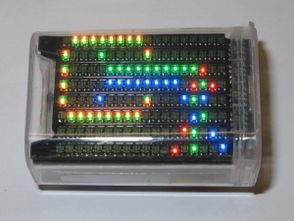TicTacLightsNanoColourEnglish: Difference between revisions
ArneRossius (talk | contribs) No edit summary |
ArneRossius (talk | contribs) No edit summary |
||
| (8 intermediate revisions by the same user not shown) | |||
| Line 19: | Line 19: | ||
The hardware is split onto two stacked PCBs, the main board and the power/data board. The main board (4 layers with blind vias) contains the LEDs, the microcontroller, the shift register ICs and the associated transistors and passives. It also contains the Micro-USB connector for mechanical reasons. The power/data board (2 layers) contains the USB to UART bridge IC, a switching converter (to generate the 5 V supply required for the RGB LEDs when using battery power) and battery charger IC as well as the MicroSD card slot. The two boards are connected through a 1.5 mm high fine-pitch connector. | The hardware is split onto two stacked PCBs, the main board and the power/data board. The main board (4 layers with blind vias) contains the LEDs, the microcontroller, the shift register ICs and the associated transistors and passives. It also contains the Micro-USB connector for mechanical reasons. The power/data board (2 layers) contains the USB to UART bridge IC, a switching converter (to generate the 5 V supply required for the RGB LEDs when using battery power) and battery charger IC as well as the MicroSD card slot. The two boards are connected through a 1.5 mm high fine-pitch connector. | ||
=== Start-up Problems === | |||
Hardware revisions 1.0 and 1.1 (all kits sold before 2021) often have an issue at power-on, all LEDs remain dark. This is caused by the shift registers outputting "low" on all pins at power-on. This causes all MOSFETs to conduct, which puts all 18 pull-down resistors of 220 Ω each across the supply in parallel. The boost converter for the 5 V supply isn't able to start up with this much load, the output voltage stops rising when it reaches around 2 V — not enough for the microcontroller. | |||
This problem can be solved by increasing the pull-down resistors (R7~R11) to 470 Ω. A suitable type is e.g. Yageo YC164-JR-07470RL (available in single quantities from Reichelt with order code "[https://www.reichelt.de/en/smd-resistor-network-1206-4x470-ohm-5-3-2x1-6x0-6-mm-bcn16-470-p42466.html BCN16 470]" — ignore their picture, it is wrong). | |||
=== Rev. 1.2 === | |||
In Rev. 1.2, R7~R11 were increased to 470 Ω. PCBs and solder paste stencils remain unchanged. | |||
* [[:Image:tictaclights-nano-colour-rev1.2.png|Schematic]] (PNG) | |||
* [[Media:tictaclights-nano-colour-instructions-rev1.2.pdf|Construction kit instructions Rev. 1.2]] | |||
=== Rev. 1.1 === | |||
Only the solder paste stencils changed for Rev. 1.1. | |||
* [[Media:TNC1.1_stencil_main.zip|Stencils for main board]] (Gerber) | |||
* [[Media:TNC1.1_stencil_pd.zip|Stencils for power/data board]] (Gerber) | |||
=== Rev. 1 === | === Rev. 1 === | ||
| Line 25: | Line 43: | ||
* [[Media:TNC1_Main.zip|PCB layout for main board]] (Gerber/Excellon) | * [[Media:TNC1_Main.zip|PCB layout for main board]] (Gerber/Excellon) | ||
* [[Media:TNC1_PD.zip|PCB layout for power/data board]] (Gerber/Excellon) | * [[Media:TNC1_PD.zip|PCB layout for power/data board]] (Gerber/Excellon) | ||
* [[Media:tictaclights-nano-colour-instructions-rev1.pdf|Construction kit instructions]] | * [[Media:tictaclights-nano-colour-instructions-rev1.1.pdf|Construction kit instructions Rev. 1.1]] | ||
== Software == | == Software == | ||
Latest revision as of 23:59, 13 November 2024
| project overview | |

| |
| Year | 2017 |
| Number of pixels | 144 |
| Grayscales / Colors | 512 |
| Illuminant | SMD LEDs (size 0404) |
| Power input | ? mW |
| Contact person | Arne Rossius |
| Project website | |
TicTacLights Nano Colour is the RGB version of TicTacLights Nano, which also fits into a mini TicTac box. Just like the monochrome version, it uses a lithium polymer battery, alternatively it can be powered from USB. The LEDs are square and only 1 x 1 mm large.
This project uses the BlinkenPlus firmware on an ATmega162 controller.
Hardware
The hardware is split onto two stacked PCBs, the main board and the power/data board. The main board (4 layers with blind vias) contains the LEDs, the microcontroller, the shift register ICs and the associated transistors and passives. It also contains the Micro-USB connector for mechanical reasons. The power/data board (2 layers) contains the USB to UART bridge IC, a switching converter (to generate the 5 V supply required for the RGB LEDs when using battery power) and battery charger IC as well as the MicroSD card slot. The two boards are connected through a 1.5 mm high fine-pitch connector.
Start-up Problems
Hardware revisions 1.0 and 1.1 (all kits sold before 2021) often have an issue at power-on, all LEDs remain dark. This is caused by the shift registers outputting "low" on all pins at power-on. This causes all MOSFETs to conduct, which puts all 18 pull-down resistors of 220 Ω each across the supply in parallel. The boost converter for the 5 V supply isn't able to start up with this much load, the output voltage stops rising when it reaches around 2 V — not enough for the microcontroller.
This problem can be solved by increasing the pull-down resistors (R7~R11) to 470 Ω. A suitable type is e.g. Yageo YC164-JR-07470RL (available in single quantities from Reichelt with order code "BCN16 470" — ignore their picture, it is wrong).
Rev. 1.2
In Rev. 1.2, R7~R11 were increased to 470 Ω. PCBs and solder paste stencils remain unchanged.
Rev. 1.1
Only the solder paste stencils changed for Rev. 1.1.
- Stencils for main board (Gerber)
- Stencils for power/data board (Gerber)
Rev. 1
- Schematic (PNG)
- PCB layout for main board (Gerber/Excellon)
- PCB layout for power/data board (Gerber/Excellon)
- Construction kit instructions Rev. 1.1
Software
This project uses the BlinkenPlus firmware.
Photos
http://arne.blinkenarea.org/TicTacLights%20Nano%20Colour/gallery.htm